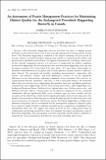| dc.description.abstract | The Poweshiek skipperling (Oarisma poweshiek) was once a common prairie butterfly in central North America, but is now critically endangered in Canada and the United States. The Poweshiek skipperling is confined to the largest remaining tall grass prairie in Canada, which is currently managed using grazing and fire to maintain prairie habitat and prevent forest and shrub encroachment. To support re-introduction, restocking, and recovery of this critically endangered species, it is necessary to understand the habitat conditions preferred by skipperlings. By surveying prairie sites with Poweshiek skipperling across age and treatment categories (1–2 y since burn, 4–6 y since burn, .15 y since burn, and grazing), we identified commonly-used nectar plants and recorded physical variables known to influence plant diversity. We measured soil variables, including macronutrients, compaction, pH, texture, and moisture content, and used multivariate statistics to test for significant differences in site characteristics and plant community across treatments. For each site, we captured plant diversity, abundance, and cover, as well as total plant biomass. We found the oldest burn sites had the fewest skipperlings. Intermediate burn sites and lightly grazed sites contained the most skipperlings. In 95% of nectaring observations, adult skipperlings were feeding on Black-eyed Susan (Rudbeckia hirta), upland white aster (Solidago ptarmicoides), and Self-heal (Prunella vulgaris). Characteristics in the physical components of sites and plant communities did not significantly differ across treatment types for most variables with the exception of the oldest burns, which showed significantly higher levels of soil compaction, live biomass, bare ground, less flowering species during the flight period, less flowering stems, and increased presence of nonnative and invasive species. Poweshiek skipperling is at high risk of imminent extirpation, and we recommend that the management regimes be adjusted to plan for a consistent supply of habitat conditions and plant species composition exemplified by our intermediate burn sites. We suggest fire return intervals of 4–6 y using patch burns in combination with grazing, permitted at times that minimize the impact on immature stages of Poweshiek skipperling. This management is needed to provide suitable habitat conditions to maintain the current population and allow for successful restocking and recovery. | en_US |

